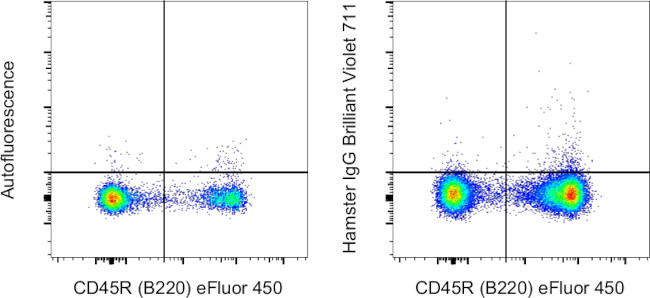Search Thermo Fisher Scientific
Invitrogen
Armenian Hamster IgG Isotype Control (eBio299Arm), Brilliant Violet™ 711, eBioscience™
图: 1 / 1
Armenian Hamster IgG Isotype Control (407-4888-81) in Flow

产品信息
407-4888-81
流式细胞分析 (Flow)
对照试剂 (Ctrl)
宿主/亚型
分类
类型
克隆号
偶联物
激发/发射光谱
形式
浓度
纯化类型
保存液
内含物
保存条件
运输条件
RRID
产品详细信息
Description: The eBio299Arm monoclonal antibody is useful as an isotype control immunoglobulin.
Applications Reported: This eBio299Arm antibody has been reported for use in flow cytometric analysis.
Applications Tested: This eBio299Arm antibody has been tested by flow cytometric analysis of normal human peripheral blood and mouse splenocytes. Use at the same concentration as the experimental antibody.
Brilliant Violet™ 711 (BV711) is a tandem dye that emits at 713 nm and is intended for use on cytometers equipped with a violet (405 nm) laser. Please make sure that your instrument is capable of detecting this fluorochrome.
When using two or more Super Bright, Brilliant Violet™, Brilliant Ultra Violet™, or other polymer dye-conjugated antibodies in a staining panel, it is recommended to use Super Bright Complete Staining Buffer (Product # SB-4401-42) or Brilliant Stain Buffer™ (Product # 00-4409-75) to minimize any non-specific polymer interactions. Please refer to the datasheet for Super Bright Staining Buffer or Brilliant Stain Buffer for more information.
Light sensitivity: This tandem dye is sensitive to photo-induced oxidation. Please protect this vial and stained samples from light.
Fixation: Samples can be stored in IC Fixation Buffer (Product # 00-8222-49) (100 µL of cell sample + 100 µL of IC Fixation Buffer) or 1-step Fix/Lyse Solution (Product # 00-5333-54) for up to 3 days in the dark at 4°C with minimal impact on brightness and FRET efficiency/compensation. Some generalizations regarding fluorophore performance after fixation can be made, but clone-specific performance should be determined empirically.
Our internal testing suggests that Brilliant Violet™ 711 (BV711) is not compatible with methanol-based fixation.
Excitation: 407 nm; Emission: 713 nm; Laser: Violet Laser.
BRILLIANT VIOLET™ is a trademark or registered trademark of Becton, Dickinson and Company or its affiliates, and is used under license. Powered by Sirigen™.
靶标信息
The isotype of a primary antibody and the application it is being used in can result in background staining. Primary antibody background noise can be caused by binding to Fc receptors on target cells; by non-specific interactions with cellular proteins, carbohydrates, and lipids; or by cell autofluorescence. Isotype control antibodies can act as negative controls to help differentiate non-specific background signal from specific antibody signal because they have no relevant specificity to a target antigen. While isotype controls are most commonly used in flow cytometry, they are useful in other applications such as chromatin immunoprecipitation (ChIP), immunohistochemistry, and gel shifts. Isotype controls should match with the primary antibody species and isotype so that the level of specific staining by the primary antibody may be accurately determined. If using directly labeled primary antibodies, the isotype control works best if conjugated with the same label as the test antibody.
仅用于科研。不用于诊断过程。未经明确授权不得转售。
生物信息学
蛋白别名: IgG; Immunoglobulin G; ImmunoglobulinG




